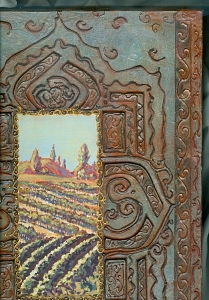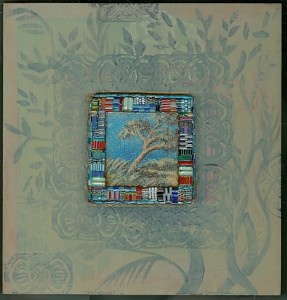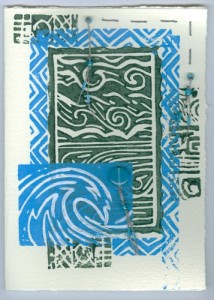Use every pre-made tool you can, but learn how to make your own tools and components.

I have mixed feelings about assemblage art: collage, stampcraft, scrapbooking, 3-D mixed media, and similar techniques.
I love them. I’ve made money from them both in the corporate art world and in freelance work. I benefit enormously from the wealth of printed and handmade papers, pre-made collage components, and stock materials available to me online and through local art suppliers.
At the same time, I’ll admit that I’ve rolled my eyes at some of the little and not-so-little scrapbooking and stampcraft empires out there. There are gorgeous examples, don’t get me wrong. But there are also a multitude of lesser crafters who just seem to fiddle around. Is it really art, I sometimes wonder, if all a crafter does is pick out some ink pad colors, glitter, paper-cutting dies, and card stock, then rearrange the parts until everything looks pretty? Is that really in the same discipline as some of the stellar collage and assemblage artists working today, who create amazing and original art? (And no, I do not include my small efforts with theirs.) Check out this Google search.
Victoriana is rife with examples of earlier hobby/home/genteel crafts, often engaged in by wealthier middle-to-upper-class women as a way to pass the time. (The lower classes were busy nailing down industrial crafts in factories, or in squinty piecework at home, and didn’t have time for such nonsense. Not much has changed, there.) Modern scholars have struck gold with a lot of those old family and shared-interest scrapbooks, xylotheques, and accessories, and some examples have been shown in high-end modern galleries and museums.
Will the same be said of today’s artfully assembled First-World cards, collage art, and scrapbooks? I have no idea.
Modern scrapbooking and stampcraft devotees do it because it’s great fun, and relatively easy and cheap to learn. It satisfies a basic need for craft and creativity. Is that fundamentally bad? No.
Do I have any right to roll my eyes at them, when I use beads that other people have made? I’ve crafted various kinds of beads, from fired stoneware, metal, blown glass, and carved bone: it’s fun, but stupidly tedious. It gave me a new appreciation for the unknown bead-crafters whose work graces archaeological finds. I’d never get anywhere if I was such a ‘pure’ craft artisan that I only used components I made myself.
But there’s where I feel I can pontificate, a little. I’ve made my own tools and components, I don’t just rely on pre-made items. When I design my own stamps and stencils, I don’t draw a design and submit it to a stamp manufacturing company for mass-market sale – I grab stock materials and cutting/carving tools, and make the goddamned stamp or stencil. A one-of-a-kind tool that I’ll use only in my own work.

And guess what? It’s not that hard. I use simple, everyday basic techniques that anyone with moderately good eye-hand coordination can learn in a day. The results are often remarkable, and I can go to sleep at night thinking ‘I made that’.
I could do a full tutorial, but some very smart people have already done it. I’ll share an overview of products and techniques I love.

Molding paste is sold by various acrylic artist’s paint manufacturers. It’s an acrylic gel medium with some variation of marble dust and/or gypsum powder to bulk it up and lend it a white-gray tone when dry. It can stiffen and texturize acrylic paints, or be used to create dimensional stencil designs on art. I know at least one art manufacturing company that would grind to a halt if there was no more molding paste in the world. You’ll need Bondo scrapers and steel palette knives to apply it. (Warning: don’t put it undiluted down a sink unless you have a plumber on speed-dial. just don’t put it down a sink AT ALL.)
Fun Foam is the trade name for 1/8″ thick closed-cell foam, usually sold in colored sheets and packages at craft stores. Kid’s craft designers use fun foam shapes because the pieces are easily cut with simple tools, and take glue well. While soft and floppy, this foam shows true versatility when used for stencils cut with craft knives. And it’s hand-washable in a sink! Most of the big shapes in the first two pieces I’ve shown above were stenciled using either fun foam or thinner plastic sheets.
Scratch Foam is nothing more than thin sheets of white plastic foam, often sold with a peel-and-stick backing for positioning on stamp block. (Psst! If you can’t find it anywhere, plastic foam plates and spray adhesive are just dandy.) Scratch foam can indented with a fingernail, a wooden stylus, or a ball-point pen. The resulting designs are perfect for stamp blocks and monoprints using acrylic paint and dyes. Washed gently in warm, soapy water, these stamps can last for many uses – especially if glued to a harder backing.
Carved stamps can be made with linocutting tools and craft knives, using a base that can range from eraser blocks, prepared woodblock linoleum or soft plastic, harder Sintra-type plastic sheets, to wood and metal. As you go up in hardness, the piece becomes more durable but harder to cut. Here are two lovely basic tutorials, and another from a major manufacturer.

Thinner cut-out stencils can be made from any stiff, fairly sturdy material cut out with laser cutter or by hand with an X-acto craft knife. Some of my thin stencils started off as Tyvek mailing envelopes, Yupo plastic watercolor paper, clear vinyl sheeting (find at upholstery suppliers), gold or silver thin foil-coated cardboard (image transfer with ballpoint pen), or cardstock paper. The latter two can be vulnerable to water damage, becoming clogged and fragile. To protect your hard work and get a little more life from those stencils, spray varnish them on both sides before first use.
Really, that’s it. It might take a few tries to get something as fine as a commercial stamp or pre-cut stencil, but you can make your own within just a few minutes to a couple of hours. And it’s all your own work…